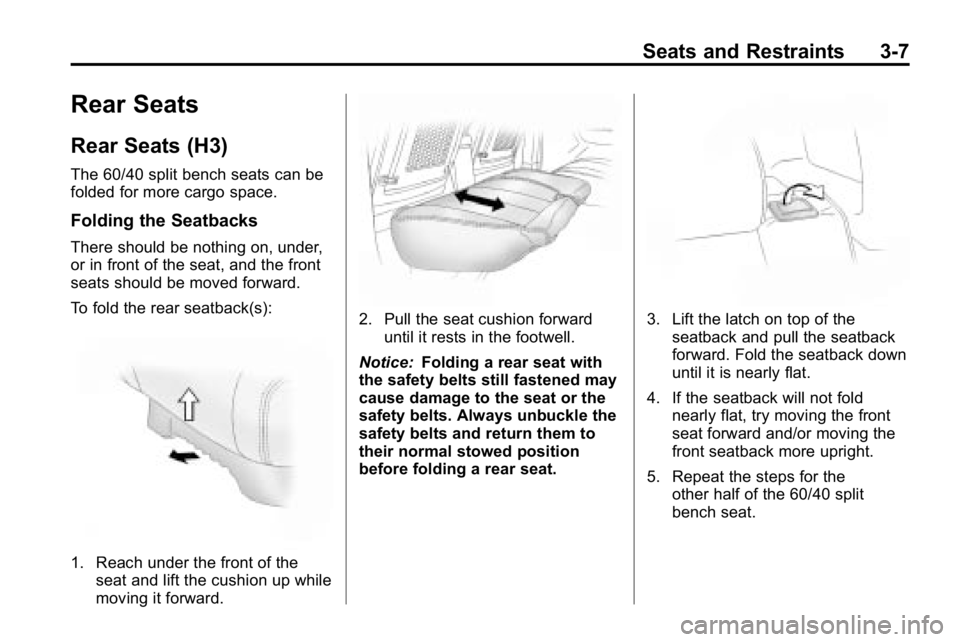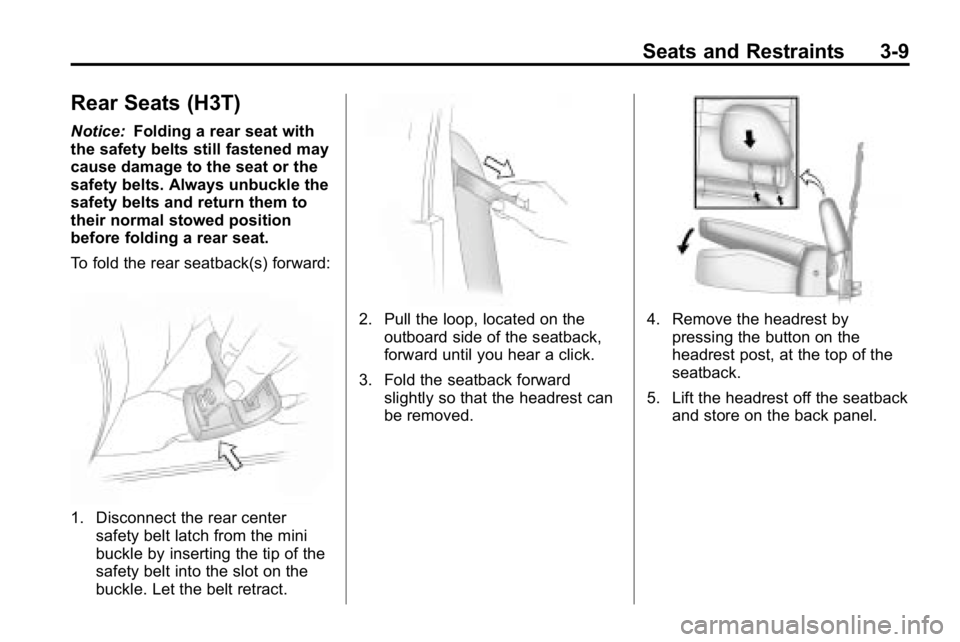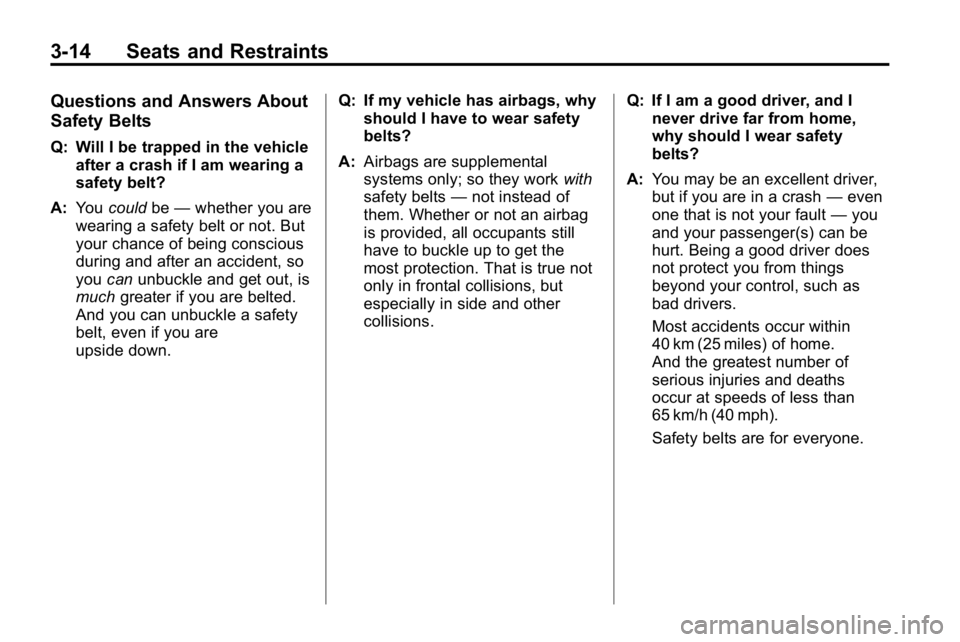HUMMER H3 2010 Workshop Manual
Manufacturer: HUMMER, Model Year: 2010, Model line: H3, Model: HUMMER H3 2010Pages: 410, PDF Size: 2.24 MB
Page 51 of 410

Seats and Restraints 3-7
Rear Seats
Rear Seats (H3)
The 60/40 split bench seats can be
folded for more cargo space.
Folding the Seatbacks
There should be nothing on, under,
or in front of the seat, and the front
seats should be moved forward.
To fold the rear seatback(s):
1. Reach under the front of theseat and lift the cushion up while
moving it forward.
2. Pull the seat cushion forward
until it rests in the footwell.
Notice: Folding a rear seat with
the safety belts still fastened may
cause damage to the seat or the
safety belts. Always unbuckle the
safety belts and return them to
their normal stowed position
before folding a rear seat.3. Lift the latch on top of the seatback and pull the seatback
forward. Fold the seatback down
until it is nearly flat.
4. If the seatback will not fold nearly flat, try moving the front
seat forward and/or moving the
front seatback more upright.
5. Repeat the steps for the other half of the 60/40 split
bench seat.
Page 52 of 410

3-8 Seats and Restraints
Returning the Seatbacks to an
Upright Position
{WARNING
If either seatback is not locked, it
could move forward in a sudden
stop or crash. That could cause
injury to the person sitting there.
Always push and pull on the
seatbacks to be sure they are
locked.
{WARNING
A safety belt that is improperly
routed, not properly attached,
or twisted will not provide the
protection needed in a crash.
The person wearing the belt could
be seriously injured. After raising
the rear seatback, always check
to be sure that the safety belts
are properly routed and attached,
and are not twisted.To return the seatback(s) to the
upright position:
1. Lift the seatback up and push it
all the way rearward.
2. Reach under the front seat and lift the cushion while moving it
rearward until it latches.
3. Pull forward on the seatback and push down on the seat
cushion to make sure the seat
is securely in place.
Page 53 of 410

Seats and Restraints 3-9
Rear Seats (H3T)
Notice:Folding a rear seat with
the safety belts still fastened may
cause damage to the seat or the
safety belts. Always unbuckle the
safety belts and return them to
their normal stowed position
before folding a rear seat.
To fold the rear seatback(s) forward:
1. Disconnect the rear center safety belt latch from the mini
buckle by inserting the tip of the
safety belt into the slot on the
buckle. Let the belt retract.
2. Pull the loop, located on theoutboard side of the seatback,
forward until you hear a click.
3. Fold the seatback forward slightly so that the headrest can
be removed.4. Remove the headrest bypressing the button on the
headrest post, at the top of the
seatback.
5. Lift the headrest off the seatback and store on the back panel.
Page 54 of 410

3-10 Seats and Restraints
To return the seatback(s) to the
upright position:
1. Lift the seatback partially andreinsert the headrest.
2. Lift the seatback completely and push it into place.
{WARNING
If either seatback is not locked, it
could move forward in a sudden
stop or crash. That could cause
injury to the person sitting there.
Always push and pull on the
seatbacks to be sure they are
locked.
3. Make sure the seatback is locked by pushing and pulling
on it.
{WARNING
A safety belt that is improperly
routed, not properly attached,
or twisted will not provide the
protection needed in a crash.
The person wearing the belt could
be seriously injured. After raising
the rear seatback, always check
to be sure that the safety belts
are properly routed and attached,
and are not twisted.
4. Reconnect the center safety belt latch plate to the mini buckle.
Make sure the safety belt is not
twisted.
5. Push and pull on the latch plate to be sure it is secure.
When the seatback is not in use, it
should be kept in the upright, locked
position.
Safety Belts
This section of the manual
describes how to use safety belts
properly. It also describes some
things not to do with safety belts.
{WARNING
Do not let anyone ride where
a safety belt cannot be worn
properly. In a crash, if you or your
passenger(s) are not wearing
safety belts, the injuries can be
much worse. You can hit things
inside the vehicle harder or
be ejected from the vehicle.
You and your passenger(s) can
be seriously injured or killed.
In the same crash, you might
not be, if you are buckled up.
Always fasten your safety belt,
and check that your passenger(s)
are restrained properly too.
Page 55 of 410

Seats and Restraints 3-11
{WARNING
It is extremely dangerous to ride
in a cargo area, inside or outside
of a vehicle. In a collision, people
riding in these areas are more
likely to be seriously injured or
killed. Do not allow people to ride
in any area of your vehicle that is
not equipped with seats and
safety belts. Be sure everyone in
your vehicle is in a seat and using
a safety belt properly.
{WARNING
People riding on the tailgate
(if equipped) can easily lose their
balance and fall even when the
vehicle is operated at low speeds.
Falling from a moving vehicle may
result in serious injuries or death.
This vehicle has indicators as a
reminder to buckle the safety belts.
See Safety Belt Reminders
on
page 5‑9for additional information. In most states and in all Canadian
provinces, the law requires wearing
safety belts. Here is why:
You never know if you will be in a
crash. If you do have a crash,
you do not know if it will be a
serious one.
A few crashes are mild, and some
crashes can be so serious that even
buckled up, a person would not
survive. But most crashes are in
between. In many of them, people
who buckle up can survive and
sometimes walk away. Without
safety belts they could have been
badly hurt or killed.
After more than 40 years of safety
belts in vehicles, the facts are clear.
In most crashes buckling up does
matter ... a lot!
Page 56 of 410

3-12 Seats and Restraints
Why Safety Belts Work
When you ride in or on anything,
you go as fast as it goes.
Take the simplest vehicle. Suppose
it is just a seat on wheels.
Put someone on it.Get it up to speed. Then stop the
vehicle. The rider does not stop.
Page 57 of 410

Seats and Restraints 3-13
The person keeps going until
stopped by something. In a real
vehicle, it could be the windshield...or the instrument panel...or the safety belts!
With safety belts, you slow down
as the vehicle does. You get more
time to stop. You stop over more
distance, and your strongest bones
take the forces. That is why safety
belts make such good sense.
Page 58 of 410

3-14 Seats and Restraints
Questions and Answers About
Safety Belts
Q: Will I be trapped in the vehicleafter a crash if I am wearing a
safety belt?
A: You could be—whether you are
wearing a safety belt or not. But
your chance of being conscious
during and after an accident, so
you canunbuckle and get out, is
much greater if you are belted.
And you can unbuckle a safety
belt, even if you are
upside down. Q: If my vehicle has airbags, why
should I have to wear safety
belts?
A: Airbags are supplemental
systems only; so they work with
safety belts —not instead of
them. Whether or not an airbag
is provided, all occupants still
have to buckle up to get the
most protection. That is true not
only in frontal collisions, but
especially in side and other
collisions. Q: If I am a good driver, and I
never drive far from home,
why should I wear safety
belts?
A: You may be an excellent driver,
but if you are in a crash —even
one that is not your fault —you
and your passenger(s) can be
hurt. Being a good driver does
not protect you from things
beyond your control, such as
bad drivers.
Most accidents occur within
40 km (25 miles) of home.
And the greatest number of
serious injuries and deaths
occur at speeds of less than
65 km/h (40 mph).
Safety belts are for everyone.
Page 59 of 410

Seats and Restraints 3-15
How to Wear Safety Belts
Properly
This section is only for people of
adult size.
Be aware that there are special
things to know about safety belts
and children. And there are
different rules for smaller children
and infants. If a child will be riding in
the vehicle, seeOlder Children
on
page 3‑42or Infants and Young
Childrenon page 3‑44. Follow
those rules for everyone's
protection.
It is very important for all occupants
to buckle up. Statistics show that
unbelted people are hurt more often
in crashes than those who are
wearing safety belts. Occupants who are not buckled up
can be thrown out of the vehicle in a
crash. And they can strike others in
the vehicle who are wearing safety
belts.
First, before you or your
passenger(s) wear a safety belt,
there is important information you
should know.
Sit up straight and always keep
your feet on the floor in front of you.
The lap part of the belt should beworn low and snug on the hips, just
touching the thighs. In a crash, this
applies force to the strong pelvic
bones and you would be less likely
to slide under the lap belt. If you
slid under it, the belt would apply
force on your abdomen. This could
cause serious or even fatal injuries.
The shoulder belt should go over
the shoulder and across the chest.
These parts of the body are best
able to take belt restraining forces.
The shoulder belt locks if there is a
sudden stop or crash.
Page 60 of 410

3-16 Seats and Restraints
Q: What is wrong with this?
A:The shoulder belt is too loose.
It will not give as much
protection this way.
{WARNING
You can be seriously hurt if your
shoulder belt is too loose. In a
crash, you would move forward
too much, which could increase
injury. The shoulder belt should fit
snugly against your body. Q: What is wrong with this?
A:
The lap belt is too loose. It will
not give nearly as much
protection this way.